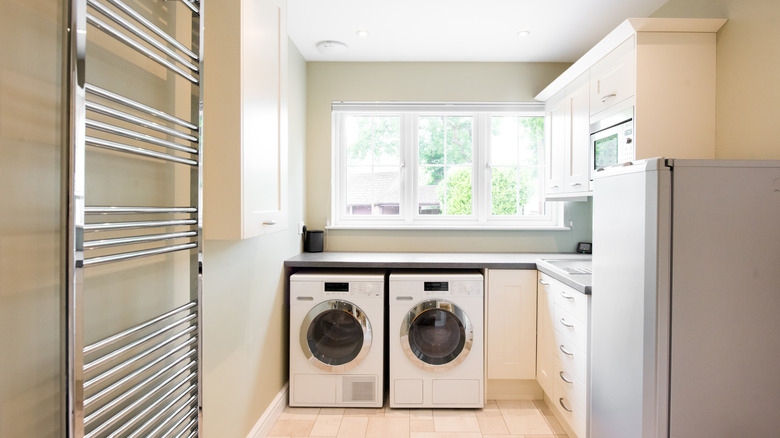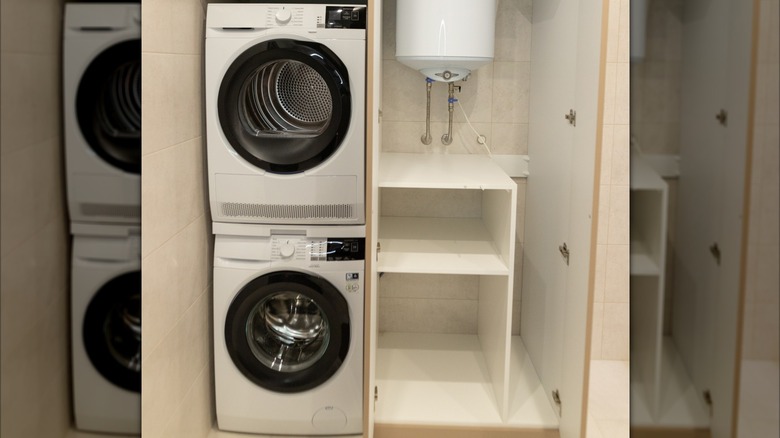The Best Ways To Find Extra Space In Your Cramped Laundry Closet
It's a lovely thing to have a dedicated room where you can toss your dirty clothes and forget about them until laundry day, but not everyone is fortunate enough to have a full-sized laundry room. Many of us must make do with much smaller laundry closets, which can quickly become cramped and cluttered. However, with a little planning and creativity, it's easier than one might think to repurpose a closet into a DIY laundry room. Naturally, a functional space that does all the heavy lifting in keeping your laundry clean must be uncluttered and organized.
To save you from having to make sheepish apologies for "all the mess," we got in touch with Maria Baer, founder of The Baer Minimalist, for an exclusive interview. She had an enlightening take on the concept of a laundry closet, wherein she proclaimed these tiny nooks to be a "minimalist's dream." According to Baer, they are generally plenty big enough to house a washer, a dryer, and a few essentials. "Unlike the laundry room, the laundry closet is all about making big things happen in a small space," she said. "One of the biggest pros of a laundry closet is the tiny footprint it takes up, which can be key in a smaller home or apartment." Baer continued to explain that in a laundry closet, you "likely don't have a folding surface, or if you do, it gets cluttered quickly because there is no space to spread out." Given that, here's how she recommends creating extra space in your cramped closets.
Add storage to your laundry closets
In her exclusive chat with House Digest, Maria Baer shared that her primary advice for maximizing every square inch in small laundry areas is to stack your washer and dryer. This will free up space for side cabinets to store cleaning supplies, vacuums, and laundry baskets. "If that is not an option, consider looking for a flat surface to go above the units to serve as a space to fold items and store your laundry baskets," she said.
What if you find accessing the upper shelves inconvenient, though, even with a stool? "You could also consider incorporating the base storage units that come as an add-on with your washer and dryer units," Baer proposed as an alternative. Obviously, for that, it's essential that the manufacturers actually offer such additional features and that you find the added convenience is worth the splurge. If not, Baer suggests adding a 4.75-inch wide rolling storage cart. It's "the perfect fit to go in between the washer [and] dryer, truly maximizing storage," she said. You can also squeeze in more storage by putting the unused space on your walls to good use. "If there is available wall space, consider adding in hooks or shelving to maximize storage potential in the space," Baer suggested. You may use these hooks to keep your hang dry clothes wrinkle free. "If you have shelving higher up, consider well-labeled or clear bins with handles, so that you can easily grab items down," Baer said.
Avoid these mistakes for the utmost utility
In her exclusive House Digest interview, Maria Baer suggested that you modify your laundry routine to achieve maximum utility if incorporating more storage isn't possible. "Consider doing a load a day and finding a different area in your home to fold items," she said. This should do away with the need for a countertop, which will serve to declutter the laundry closet. "Something I've implemented for our family is limiting the amount of clothing we purchase that needs to be hung to dry," Baer explained. "This has allowed me to eliminate the need for a drying rack in our laundry room, which also doubles as our mudroom."
Another way to free up space in your laundry closet is to return to the drawing board and take stock of its purpose. "With a small space, you may have to come to grips with the fact that the room/closet needs to serve as a single-use space," Baer said. "A laundry closet likely won't be able to hold your tools, your Costco backstock, your entertaining goods, etc. It needs to have the essentials for doing laundry, and probably not much more." Finally, Baer insists on paying attention to ventilation. "With the moisture coming from the washing machine and the small enclosed space, you will want to make sure that moisture doesn't get trapped in the space, causing a musty smell or worse yet, mold." The solution, Baer said, is to "consider doors that provide some ventilation or add a vent fan," and make sure that the fan runs throughout the load cycles.


